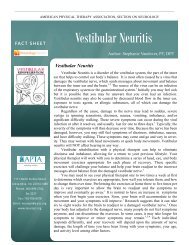Practice Guidelines for BPPV - Neurology Section
Practice Guidelines for BPPV - Neurology Section
Practice Guidelines for BPPV - Neurology Section
Create successful ePaper yourself
Turn your PDF publications into a flip-book with our unique Google optimized e-Paper software.
Vestibular SIG Newsletter <strong>BPPV</strong> Special Edition<br />
Differential Diagnosis and Treatment of Anterior Canal Benign<br />
Paroxysmal Positional Vertigo<br />
Janet Odry Helminski, PT, PhD<br />
Midwestern Univeristy<br />
Benign Paroxysmal Positional Vertigo (<strong>BPPV</strong>) may involve<br />
1 or more of the 3 semicircular canals. Of the 3 canals,<br />
the anterior canal (AC) is least often affected due to the<br />
AC’s anatomically superior position during most<br />
activities and the descent of the long arm directly into<br />
the common crus and vestibule resulting in debris selfclearing.<br />
The incidence of AC-<strong>BPPV</strong> is reported at 1.5-<br />
19% of <strong>BPPV</strong> cases 1-3 . Differential diagnosis and<br />
treatment of AC-<strong>BPPV</strong> is difficult due to the canal plane<br />
orientation, the relative canal position, and the radii of<br />
curvature of the AC. The purpose of this review is to<br />
discuss the differential diagnosis of AC-<strong>BPPV</strong> and to<br />
describe particle repositioning maneuvers designed to<br />
treat the AC-<strong>BPPV</strong>.<br />
Anatomical Comparison of the Vertical Canals<br />
The anatomical alignment of the AC is very different<br />
than the posterior canal (PC) and creates challenges in<br />
identifying and managing AC-<strong>BPPV</strong>. The relative position<br />
of the initial ampullary segment to the vestibule is<br />
superior <strong>for</strong> the AC and inferior <strong>for</strong> the PC (Figure 1). In<br />
the upright position, the initial ampullary segment of the<br />
AC is roughly vertical (70° with respect to the earth<br />
horizontal) while the ampullary segment of the PC is<br />
approximately 20° below the earth horizontal 4 . The near<br />
vertical initial ampullary segment of the AC alters the<br />
radii of curvature of the AC hindering otoconia from<br />
clearing the long arm of the AC. In <strong>BPPV</strong>, activation of<br />
© 2007, Janet O. Helminski. Reprinted with permission.<br />
Figure 1. Left inner ear.<br />
Figure 1.<br />
Left inner<br />
ear<br />
6<br />
a canal generates a nystagmus that is in the plane of<br />
the canal 5 . In the upright position, using the Reid<br />
stereotaxic coordinate system, the AC is 41° from the<br />
sagittal plane while the PC is 56° from the sagittal<br />
plane 6 . The pattern of nystagmus reflects canal<br />
placement because the rotational axis of the<br />
nystagmus is orthogonal to the plane of the canal 5 .<br />
There<strong>for</strong>e, the vector of ocular nystagmus from the AC<br />
is primarily downbeating with little or no torsion while<br />
the vector of ocular nystagmus from the PC is primarily<br />
torsional (superior pole directed towards the involved<br />
ear) and upbeating 5 . The differences in anatomical<br />
alignment between the AC and PC need to be<br />
considered during positional testing and particle<br />
repositioning maneuvers.<br />
Differential Diagnosis of <strong>BPPV</strong><br />
To <strong>for</strong>mulate a physical therapy differential diagnosis, a<br />
thorough history and neurologic examination is<br />
per<strong>for</strong>med to identify <strong>BPPV</strong> from other potential<br />
causes of positional vertigo such as orthostatic<br />
hypotension, low spinal fluid pressure, and brainstem<br />
or cerebellar dysfunction. Cervical spine and vertebral<br />
artery screening tests should be included prior to<br />
positional testing to identify limitations and potential<br />
contraindications to per<strong>for</strong>ming the positional tests.<br />
Once the cervical spine and vertebral artery are<br />
cleared, positional testing is per<strong>for</strong>med.<br />
History of <strong>BPPV</strong><br />
The diagnosis of AC-<strong>BPPV</strong> is based on history and<br />
clinical findings on positional testing – both subjective<br />
and objective 7 . The history is critical in the <strong>for</strong>mation<br />
of a differential diagnosis. From the history alone,<br />
<strong>BPPV</strong> is detected with a specificity of 92% and a<br />
sensitivity of 88% 8 . If the patient complains of<br />
symptoms when getting out of bed and rolling over in<br />
bed, the patient is 4.3 times more likely to have <strong>BPPV</strong> 9 .<br />
Key activities that evoke symptoms are when the<br />
patient looks up, gets out of bed, moves the head<br />
quickly, rolls over in bed and bends <strong>for</strong>ward 9 . If the<br />
patient complains of symptoms when bending the<br />
head <strong>for</strong>ward to read or reports sleeping in the prone<br />
position, AC-<strong>BPPV</strong> is suspected.<br />
(Continued on page 18)

















